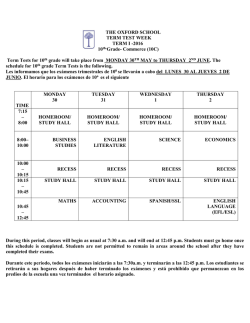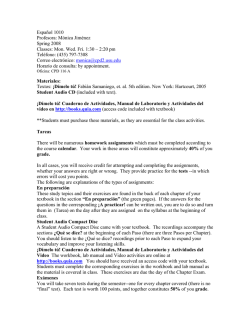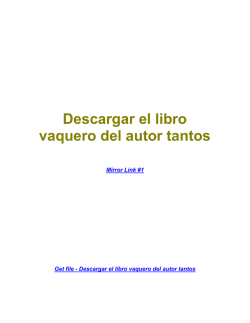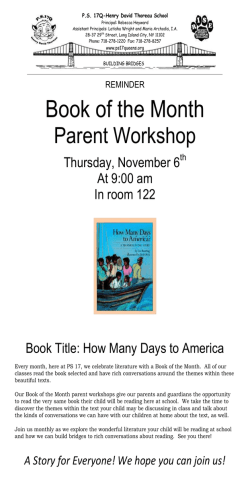
spanish 3 - Long Beach City College
SPANISH 3 COURSE DESCRIPTION FALL 2015 COURSE TITLE: Intermediate Spanish (Part I) (Class Number 73336) 5 units This course fulfills part of the UC/CSU Transfer Breadth requirement from Area C (Arts & Humanities). If you are serious about using the language within your vocation, or to facilitate regular communication with family members, business associates, and/or friends, a minimum of four semesters of Spanish is recommended. INSTRUCTOR: Profesora Carla (Charlotte Jackson) OFFICE LOCATION: M-202 Office Phone: (562) 938 – 4335 E-mail: [email protected] Office Hours: Tues 8:00-11:15 am; Thurs 9:30-11:15 am Please contact a fellow student for the homework, if you are absent. If you need to e-mail me for any other reason, please identify yourself (first & last name) and the course you are in (as well its day & time). DAY, LOCATION, & TIME: Tuesdays & Thursdays, 11:20 a.m. to 1:50 p.m. in M204. Herewith the normal schedule: 11:20 to 12:30 class; 10-minute break; 12:40 to 1:40 class. Although we do not have a required lab hour in the Foreign Languages Lab, you will need to build online time into your schedule each week to complete activities including those in the publisher’s web site that accompanies the textbook. To be successful in this course, you should plan to invest 10 hours of study outside of class each week. ADD POLICY: Foreign language classes are limited to no more than 35 students, not only to enhance the quality of instruction in the class, but also because of limited space in the Foreign Language Lab. Anyone who is absent during roll call may be dropped in order to open space for people who are present if their names are on a waiting list (accepted in the order in which they signed up). In the unlikely event that there is space left in the class after all the people on the waiting list (and who are present) have been accommodated, petitioners will be accepted on a lottery basis. Petitioners must use the permission number given to add the course prior to the following class, or they may lose their space. ATTENDANCE POLICY: Students not attending the first class session may be dropped from the class at the discretion of the instructor. In the event of excessive absences (15 hours or more), the instructor may drop a student from a course or may lower a student’s grade. Students who are absent for two weeks in a row may be dropped from class. Students who stop attending but do not drop the course before the withdrawal deadline will receive an “F” or an “N/P” according to the grading option chosen. Please remember that it is your responsibility to drop this (or any) course, should you need to do so. PREREQUISITE: Recent successful completion (C grade or better within the last two years) of college level Spanish 2 or the equivalent. Note that if you already speak Spanish regularly at home and/or with relatives and friends, then you should sign up for Spanish 9 (Spanish for Spanish Speakers). If you have recently successfully completed three or more semesters of college level Spanish, or three or more years of high school Spanish, then you should sign up for a higher level class. Be prepared to show the department chair a transcript or report card to demonstrate successful completion, and fill out the prerequisite waiver form. Download the form at http://www.lbcc.edu/admissions/documents/ChallengeForm.pdf. STUDENT LEARNING OUTCOMES Upon successful completion of the course the student should be able to: 1. Demonstrate reading comprehension at a medium intermediate level in the target language. 2. Demonstrate aural comprehension at a medium intermediate level in the target language. 3. Formulate ideas orally at a medium intermediate level in the target language. 4. Formulate ideas in writing at a medium intermediate level in the target language. 2 SPANISH 3 CURRICULUM (based on Chapters 1–5 of the textbook Imagina 3e, published by Vista) 1. Review of regular and common irregular present-tense verbs; ser and estar; gustar and similar verbs 2. Review of preterite, imperfect, and preterite vs. imperfect 3. The subjunctive in noun clauses (Mamá quiere que tú hables con la abuelita.) 4. Object pronouns (direct, indirect, object of prepositions; double object pronouns) 5. Commands (formal, informal, nosotros/as) 6. The subjunctive in adjective clauses (Necesitamos un carro que cueste menos de $6.000.) 7. Verbs that can be used reflexively or non-reflexively; reciprocal actions; reflexive pronoun in conjunction with direct object pronoun 8. Por and Para 9. The future tense 10. The conditional 11. Relative pronouns (que, el que, el cual, quien) and adjectives (cuyo) 12. Vocabulary related to personal relationships, feelings, personality characteristics; town locations; media; family and stages of life; nature and animals; ecology; vocabulary terms used in cultura and literatura sections SPECIFIC COURSE REQUIREMENTS 1. Attendance/Participation. Attendance on a regular basis is vital in any foreign language class; your success is tied directly to your level of participation and involvement. Do your best to practice using Spanish during class. Since we are a community of learners, any absence or lack of participation may negatively affect those around you: You are needed! Absences will lower the attendance/participation portion of the grade (10% of overall grade). Herewith the breakdown: 0– 6 hours absent = A; 7-9 hours = B; 10-12 hours = C; 13-14 hours = D; 15 hours or more: Drop, overall grade lowered, or Fail. Ten or more hours’ absence will automatically lower the participation portion of the grade: 10 hours = C/B. Three instances of arriving late, leaving early, or walking out in the middle of class will count as one hour’s absence. Students late more than 15 minutes will be charged a minimum of half an hour’s absence. A doctor’s note or written verification of court attendance will be necessary in order to excuse an absence. Students with excessive absences will be dropped from the course or the overall grade assigned will be an F. Please do not sign up for this class if you are not able to regularly attend during the scheduled hours of instruction. If you arrive a little late, be sure to check with me during a break or after that same class to verify your attendance on the roll sheet. Please note: In order to be considered to be “present,” you need to be focused on the class presentation/activity. Participation means not only that you bring class materials, but that you conduct yourself in a cooperative manner. OJO: “Studies have shown that working more than 20 hours a week increases the likelihood that a student will drop out of college.” (National Association of Higher Education Advocate) Note that we will be taking a break mid-way through class. This is your opportunity to get up and stretch, get a drink, use the restroom, call someone, etc., rather than arriving late or disrupting class while it is in session. Absolutely no earbuds/ texting/social media/personal surfing during class! Unauthorized use of electronic devices during class will result in the student’s being charged one hour’s absence per incident; the student may also be asked to leave the classroom. (“Unauthorized” means anything not directly related to class.) If three such instances occur, you will lose the privilege of using any electronic device in class for the remainder of the course. 2. Daily preparedness. Language courses are not lecture courses. They are participation courses, so in order to derive maximum benefit you should carefully complete the assignment (including lab assignments) and be up to date each day. New material is based on previously learned material, so don’t get behind. Seek tutorial help early on if you are experiencing difficulty. Remember: audio-lingual skill development comes only with practice, so don’t hesitate to speak out and participate. Studying with a classmate is beneficial. Exchange contact information with a classmate in case you need to find out the homework assignment. 3. Daily Assignments. As the semester progresses, you will complete daily assignments to help you develop and improve your communication skills. Specific assignments will be collected from time to time, primarily from the Student Activities Manual (SAM, also referred to as el Cuaderno). The SAM consists of two parts: the Workbook and the Lab Manual. Each chapter (excluding composition) is worth 15 points. One point will be deducted for each incomplete or uncorrected 3 single-item response exercise; no credit will be given if there are 15 or more incomplete exercises. DON’T FORGET to do the Lab Manual exercises for each chapter (beginning on p. 121). To complete these activities, you will need to go online to hear the audio (or you can get an mp3 file from Instructional Associate Mich Touch in the Foreign Language Lab in M103). Each chapter of the Workbook ends with a Composición section. For the first three chapters, you may complete the activities by writing in the workbook itself; these Composición activities will be worth 10 points each. For Chapters 4 and 5, you will be writing longer compositions, which you will be handing in on separate paper. Additional tasks will be assigned, including oral presentations, and quizzes scheduled as warranted, to evaluate your progress. You will need to have, complete, and turn in a hard (print) copy of the SAM to receive credit. You may turn in no more than two late assignments. No late assignment will be accepted beyond the next-to-last week of the semester. 4. Tests. You will demonstrate your mastery by completing a variety of written exams, including shorter quizzes, WHICH MAY BE UNANNOUNCED, as well as chapter tests. There will be no make-ups. However, you may miss one chapter exam (but not the final). If you take all chapter exams, then the one with the lowest grade (other than the final) will be dropped. 5. Language Lab: The Language Lab is located in M–103. This course does not require that you sign in and attend lab on campus each week. However, you are welcome to use the lab during open hours (see www.lbcc.edu/foreignlanguage for the schedule) to access the Vista Supersite, or to access the free components of other Spanish language textbooks, to review/practice. Please note that you will need to have regular online access to complete the online component of the textbook. You will receive points for completing the specified lab activities. STUDENT CONDUCT While you are in class, it is important that you remain focused and do your best to practice using what you are learning. Please, please, please: cover up your sneeze/cough! Academic Honesty - Lack of honesty in the classroom is considered a very serious offense. There are no “in and out” privileges during a test. Any form of cheating on tests, turning in work which is not one's own (plagiarism), talking or using electronic devices during tests, furnishing false information to instructor, or knowingly misrepresenting oneself to the college (i.e. signing in for someone else on attendance sheets) is grounds for disciplinary action. The consequences of cheating are severe and may include failing the course and/or expulsion from the college. Read carefully the Guidelines for Creating a Collegiate Environment in the LBCC Schedule or College Catalogue. For example: “Disorderly, lewd, indecent, obscene attire or conduct, including profanity; and conduct which disrupts orderly operation of the college, or which disrupts educational activities of individual members of the college community,” can subject students to disciplinary action. If you disrupt any class, the instructor has the right to ask you to leave. You may not be allowed to return to class until you have spoken to the instructor, department chair, area dean, and/or the dean of student affairs. To sum up: Act as a mature, responsible adult. Please treat others as you would wish to be treated. SCHOLARSHIPS: Did you know you can receive $500 or more for studying a foreign language at LBCC? The Scholarship Office is located in Admissions & Records (A-1001); download the application at www.lbcc.edu/scholarship. Applications are generally due the first week of December; scholarships are typically disbursed the following May. GRADING for the course overall is broken down as follows: 10% class attendance/participation; 25% quizzes, written assignments (including SAM workbook/lab manual and online exercises); 45% chapter tests; 20% comprehensive final. An example of grading on any quiz/test: 92–100% = A; 90–91% = A–; 88–89% = B+; 82–87% = B; 80–8l% = B– ; etc. Less than 60% = F. 4 The Learning and Academic Resources Department offers services and classes designed to help you improve your academic performance. Free tutoring, study skills assistance, computers, and more are available at both campuses. For more information visit: www.lbcc.edu/lar or contact the Multidisciplinary Student Success Centers at LAC (L-212 562 983 4699) or at PCC (EE-206 562 938-3991). REQUIRED* MATERIALS •Imagina: Español sin barreras, Third Edition by José A. Blanco and C. Cecilia Tocaimaza-Hatch (Vista Higher Learning: Boston, 2015) along with the accompanying Student Activities Manual or SAM (a combined workbook & lab manual with Answer Key), and Supersite Code. You will need the hard (print) copy of the workbook to hand in, in order to receive credit. Note the Long Beach City College Custom Edition bundle will cost less than buying the elements separately. To set up your account, go to https://www.vhlcentral.com/section/328842/student_instructions?instructor=1 •Notebook paper; pencil & eraser or pen and (recommended) correction fluid (for taking notes; in-class writing assignments) •Valid e-mail address on the class roster *OJO: Required means mandatory. DO NOT WAIT for a financial aid check to come. Pay for the books now, and use the financial aid check to reimburse yourself. Each student should have both the textbook and the Student Activities Manual. Recommended: quick access to an online Spanish-English dictionary on your smartphone or iPad, or a paperback bilingual Spanish-English dictionary. Here’s the web site of a good online Spanish-English dictionary: http://dictionary.reverso.net/spanish-english/. Vista Higher Learning http://vistahigherlearning.com/supersite-resources. You’ll find information about our live and pre-recorded training sessions, quick how-to videos, user guides and more. PURCHASING A SUPERSITE CODE This class requires technology access. This access allows you to complete and submit assignments and tests; access all media and study tools; receive announcements; and communicate with your instructor. Shop smart: only buy books that include the required Supersite code! You will spend more if you purchase the textbook and code separately. New textbooks purchased at the bookstore will include this code. Most books that are sold online or used DO NOT include the access code. Always check that what you are buying includes the code. For value-priced packages, and free shipping, visit https://www.vhlcentral.com/store/328842. SETTING UP YOUR ACCOUNT https://www.vhlcentral.com/section/328842/student_instructions?instructor=1 Returning Students If you have an existing Supersite account for any Vista Higher Learning textbook, complete these steps: Go to vhlcentral.com Log in using your existing account information. Choose one of these options: Already have access to the Supersite for this course? Enroll in the course by clicking the "Enroll in a course" link. Then complete "Step 5 - Select a Course/Class" below. OR Don't yet have access to the Supersite for this course? Redeem your new Supersite code by clicking the "Redeem a code" link. Then complete "Step 3 - Activate Code" below. New Students If you are new to Vista Higher Learning, complete these steps: Step 1 - Go to vhlcentral.com Step 2 - Choose one of these options: Did you buy your code at the online Store? If you created a student account on the store, use the same login information. If you can see your course book on the home page after logging in, go to "Step 5 -Select a Course/Class." If no book appears, go to "Step 3 - Activate Code." OR Create an Account In the "Login Information" section of the account creation page, enter a username of your choice. Enter the email address you would like to associate with your account. Enter and confirm a password of your choice. In the "Personal Profile" section, enter your first and last name as you wish them to appear in your Instructor's roster. Select the year of your birth from the drop down list. Enter a student ID (optional). In the "Security Information" section, provide the answer to a secret question, which may later be used to help you access your account if you forget your password. After you enter all of the information, click "create an account." Click "agree." (Before your account is created, you must agree to the terms and conditions of use policy.) Step 3 - Activate Code On the code activation screen, enter your Supersite code. Click "activate code" to continue. Look for a message at the top of the screen confirming that the code was successfully redeemed. Step 4 - Select a School Locate your school by typing your school’s name, Long Beach CC-Liberal Arts Campus. To narrow the search results, add the city and state, Long Beach, CA , (include the country, if outside of the USA.) in which your school is located. Click "find." If the terms you entered did not result in a successful search, follow the on-screen tips to revise your search. Select your school from the list by clicking on its name. Click "select school" to add the school to your account. Look for a message at the top of the screen confirming you successfully added the school. Step 5 - Select a Course/Class From the list of available classes at your school for your textbook's Supersite, look for Instructor "Jackson" and the course "Spanish 3" taught between 08/01/2015 and 12/31/2015. It should look like this: Jackson Spanish 3 Course Nbr… Click the radio button for the course section "Course Nbr 73336." If more than one class is listed for your instructor, click the information icons in the class listings until you locate the section. Click Save. You should see a confirmation that you successfully enrolled in your instructor's course. FECHAS IMPORTANTES: No hay clases en LBCC en estas fechas: lunes 7 de septiembre (Labor Day), martes 22 de septiembre (Flex Day), miércoles 11 de noviembre (Veterans Day), jueves-viernes 26-27 de noviembre (Thanksgiving). Fall 2105 Tuesday-Thursday classes: 30 class sessions including final ASIGNATURAS y CALENDARIO TENTATIVO En el SUPERSITE: Para CADA CAPÍTULO: Haz todas las actividades señaladas para el día ANTES del examen. LECCIÓN 1 (5 días: del 25 de agosto al 8 de septiembre. Examen el martes 8 de septiembre; entrega [hand in] ese día tu cuaderno [Student Activities Manual] con las págs. 1-11 y 121-126 completadas y corregidas siempre que sea posible [whenever possible].) A. Para empezar: libro de texto págs. 2-5 B. SAM (Student Activities Manual) págs. 1-2 (Workbook Section); 121 (Lab Manual Section) C. Cortometraje: libro de texto págs. 6-11 D. Imagina: libro de texto págs. 12-17 E. SAM págs. 3-4 F. Estructura 1.1 libro de texto págs. 18-21 G. SAM págs. 5-6; 122 H. Estructura 1.2 libro de texto págs. 22-25 I. SAM págs. 7-8; 123 J. Estructura 1.3 libro de texto págs. 26-30 K. SAM págs. 9-11; 124 (pág. 11: Composición: No incluyas aquí ni la lista de tus ideas ni el borrador [rough draft], escribe nada más la composición en el cuaderno [workbook]. Escribe entre 50 y 75 palabras.) L. Cultura: libro de texto págs. 31-34 M. Literatura: libro de texto págs. 35-38; SAM págs. 125-126 N. Otro: LECCIÓN 2 (6 días: del 10 de septiembre al primero de octubre. Examen el jueves primero de octubre; entrega [hand in] ese día tu cuaderno con las págs. 13-23 y 128-132 completadas y corregidas.) A. Para empezar: libro de texto págs. 40-43 B. SAM (Student Activities Manual) págs. 13-14; 127 C. Cortometraje: libro de texto págs. 44-49 D. Imagina: libro de texto págs. 50-55 E. SAM págs. 15-16 F. Estructura 2.1 libro de texto págs. 56-59 G. SAM págs. 17-18; 128 H. Estructura 2.2 libro de texto págs. 60-63 I. SAM págs. 19-20; 129 J. Estructura 2.3 libro de texto págs. 64-68 K. SAM págs. 21-23; 130 (pág. 23: Composición: Escribe entre 30 y 50 palabras por párrafo) L. Cultura: libro de texto págs. 69-72 M. Literatura: libro de texto págs. 73-76; SAM págs. 131-132 N. Otro: LECCIÓN 3 (6 días: del 6 de octubre al 2 de octubre. Examen el jueves 22 de octubre; entrega ese día tu cuaderno con las págs. 25-35 y 134-138 completadas y corregidas.) A. Para empezar: libro de texto págs. 78-81 B. SAM (Student Activities Manual) págs. 25-26; 133 C. Cortometraje: libro de texto págs. 82-87 D. Imagina: libro de texto págs. 88-93 E. SAM págs. 27-28 F. Estructura 3.1 libro de texto págs. 94-99 G. SAM págs. 29-30; 134 H. Estructura 3.2 libro de texto págs. 100-103 I. SAM págs. 31-32; 135 J. Estructura 3.3 libro de texto págs. 104-108 K. SAM págs. 33-35; 136 (pág. 35: Composición Paso 1: Subraya en el párrafo los pronombres de complemento directo e indirecto. Paso 2: Subraya tus usos del subjuntivo. Utiliza el verso [back side] de la página si es necesario.) L. Cultura: libro de texto págs. 109-112 M. Literatura: libro de texto págs. 113-116; SAM págs. 137-138 N. Otro: LECCIÓN 4 (6 días: del 27 de octubre al 12 de noviembre. Examen el jueves 12 de noviembre; entrega ese día tu cuaderno con las págs. 37-47 y 140-144 completadas y corregidas.) A. Para empezar: libro de texto págs. 118-121 B. SAM (Student Activities Manual) págs. 37-38; 139 C. Cortometraje: libro de texto págs. 122-127 D. Imagina: libro de texto págs. 128-133 E. SAM págs. 39-40 F. Estructura 4.1 libro de texto págs. 134-137 G. SAM págs. 41-42; 140 H. Estructura 4.2 libro de texto págs. 138-141 I. SAM págs. 43-44; 141 J. Estructura 4.3 libro de texto págs. 142-146; 142 K. SAM págs. 45-47 (pág. 47: Composición: Paso 1: Escribe 50 palabras; utiliza el verso [back side] si es necesario. Paso 2: Escribe en una hoja aparte [separate sheet]; escribe tu composición en la computadora con los acentos impresos [no escritos a mano], imprímela [print it] y entrégala. De acuerdo con las instrucciones, incluye usos del subjuntivo, de verbos reflexivos y de las preposiciones por y para. Subraya todos estos usos en tu composición. OJO: Escribe a doble espacio [double-space]. Usa Times New Roman con una fuente de 12 ó 14 puntos. Debe tener una extensión de 150 a 250 palabras.) L. Cultura: libro de texto págs. 147-150 M. Literatura: libro de texto págs. 151-154; SAM págs. 143-144 O. Otro: LECCIÓN 5 (7 días: del 17 de noviembre al 10 de diciembre. Examen final el jueves 10 de diciembre; entrega ese día tu cuaderno con las págs. 49-59 y 145-150 completadas y corregidas.) A. Para empezar: libro de texto págs. 156-159 B. SAM (Student Activities Manual) págs. 49-50; 145 C. Cortometraje: libro de texto págs. 160-165 D. Imagina: libro de texto págs. 166-171 E. SAM págs. 51-52 F. Estructura 5.1 libro de texto págs. 172-175 G. SAM págs. 53-54; 146 H. Estructura 5.2 libro de texto págs. 176-179 I. SAM págs. 55-56; 147 J. Estructura 5.3 libro de texto págs. 180-184 K. SAM págs. 57-59; 148 (pág. 59: Composición: Paso 1: Lee el artículo. Paso 2: Escribe en una hoja aparte [separate sheet]; escribe tu composición en la computadora con los acentos impresos [no escritos a mano], imprímela [print it] y entrégala. De acuerdo con las instrucciones, incluye usos del futuro, del condicional y de los pronombres relativos. Si prefieres, puedes escribir sobre otro asunto [subject] relacionado a las riquezas naturales: la desaparición de ciertos especies en peligro de extinción, la destruccón de los bosques, la contaminación ambiental, etcétera, pero siempre con usos del futuro, del condicional y de los pronombres relativos. Subraya todos estos usos en tu composición. OJO: Escribe a doble espacio [doublespace]. Usa Times New Roman con una fuente de 12 ó 14 puntos. Debe tener una extensión de 150 a 250 palabras.) L. Cultura: libro de texto págs. 185-188 M. Literatura: libro de texto págs. 189-192; SAM págs. 149-150 N. Otro:
© Copyright 2024



